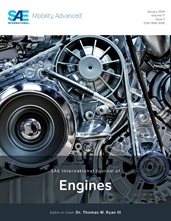Reduction of Nitrogen Oxides by Injecting Nitric Oxide into a Hydrogen Engine: A Micro-kinetic Analysis
- Content
- The effect of injecting nitric oxide (NO) on reducing the emissions of NO from a hydrogen-fuelled spark-ignited internal combustion engine (H2-ICE) is studied using a detailed engine model considering in-cylinder turbulence and heat losses. Two different micro-kinetic models, one consisting of 307 reactions and 43 species and the other consisting of 126 reactions and 23 species, are used to predict the temporal evolution of the NO concentration in the exhaust of a single-cylinder four-stroke engine. Simulations show that a net reduction in the amount of NO can be obtained for high equivalence ratios (= 0.9), whereas a reduction is not predicted for a low equivalence ratio of 0.6. For both the equivalence ratios, the injection of NO does not impact the in-cylinder pressure and temperature profiles. It is deduced that the reduction in NO is primarily due to thermodynamic limitations. An analysis of the kinetic parameters for reactions involving the fuel (H2) and NO shows that the fuel reburning reactions do not play a role in the reduction of NO. The present work can be used to design selective nitrogen oxide (NOx) recirculation (SNR) systems, wherein a fraction of the exhaust rich in NO is selectively recirculated back into the engine. Although this work has been performed by considering H2 as the fuel, the concept of reducing NOx emissions because of equilibrium limitations is expected to be applicable to other fuels as well.
- Pages
- 26
- Citation
- Agarwal, S., Srivastava, V., Kherdekar, P., and Bhatia, D., "Reduction of Nitrogen Oxides by Injecting Nitric Oxide into a Hydrogen Engine: A Micro-kinetic Analysis," SAE Int. J. Engines 14(4):467-491, 2021, https://doi.org/10.4271/03-14-04-0028.
